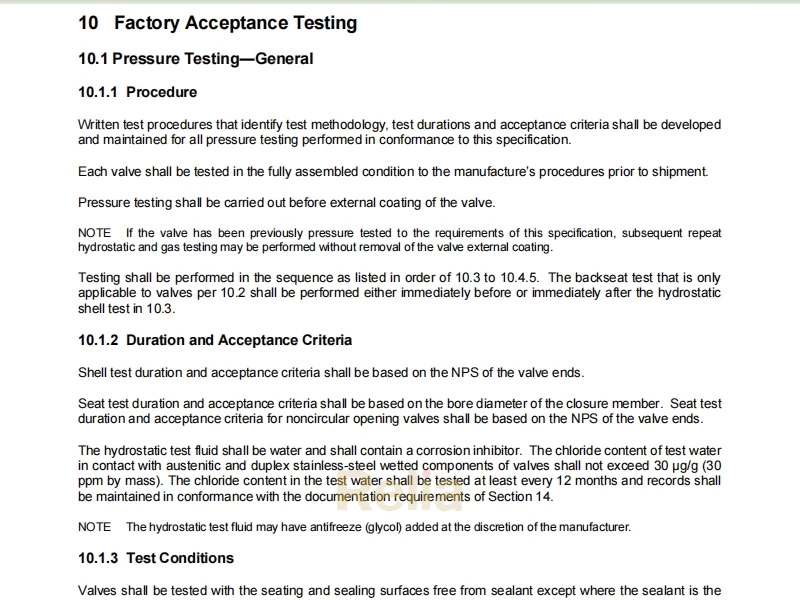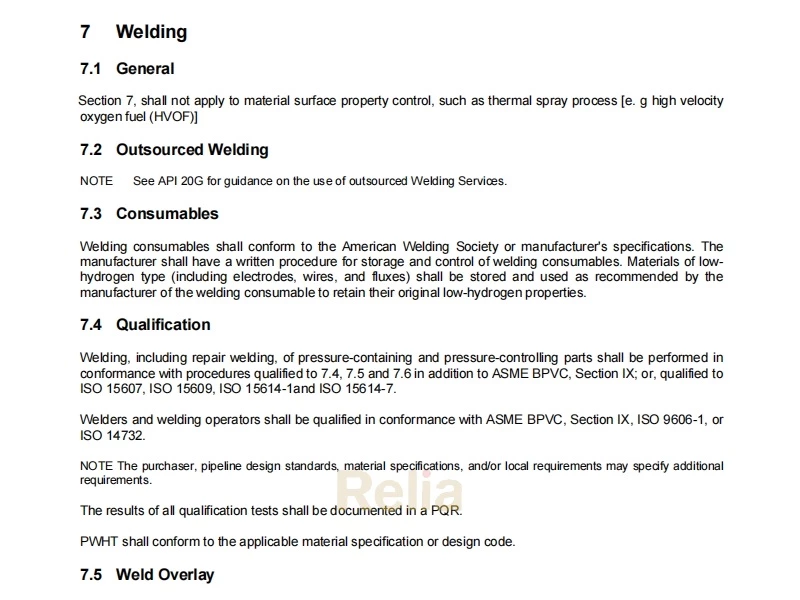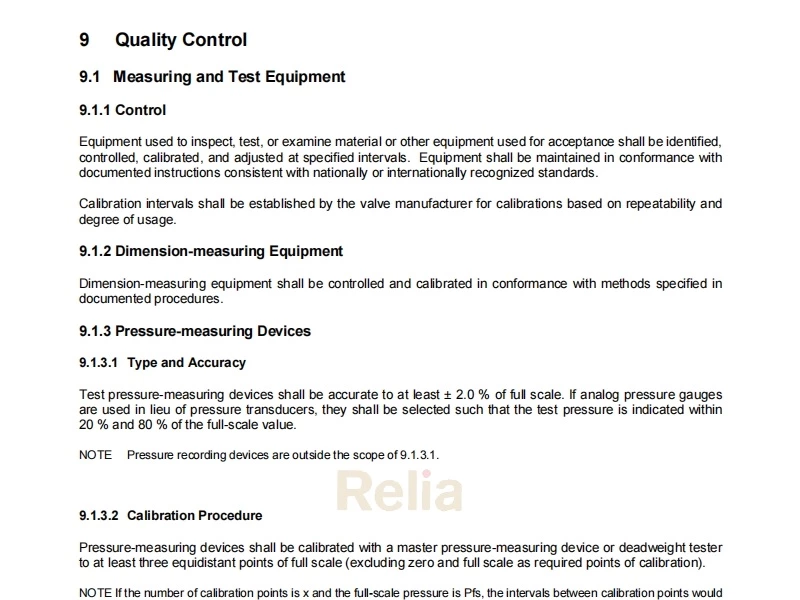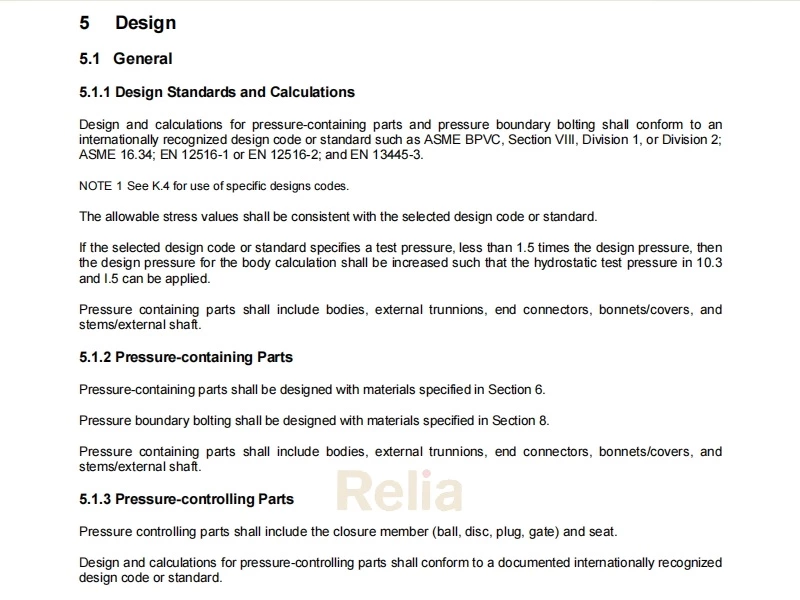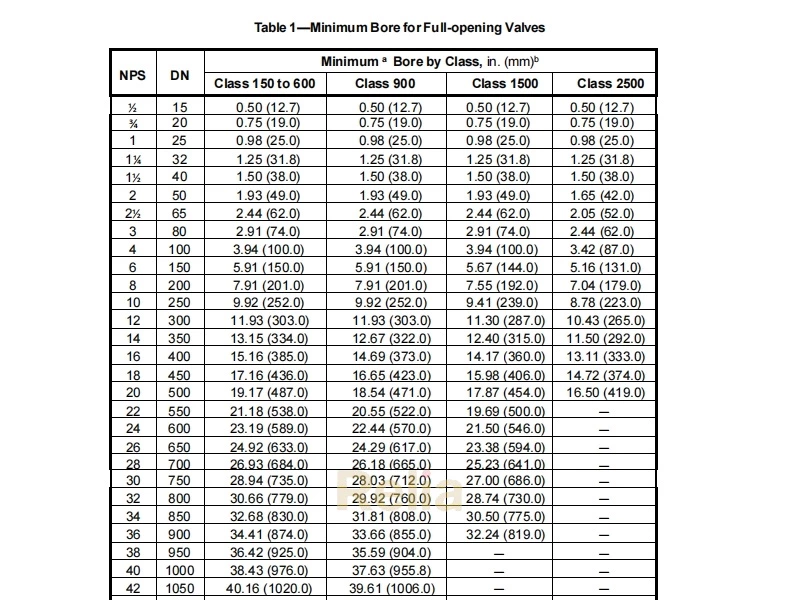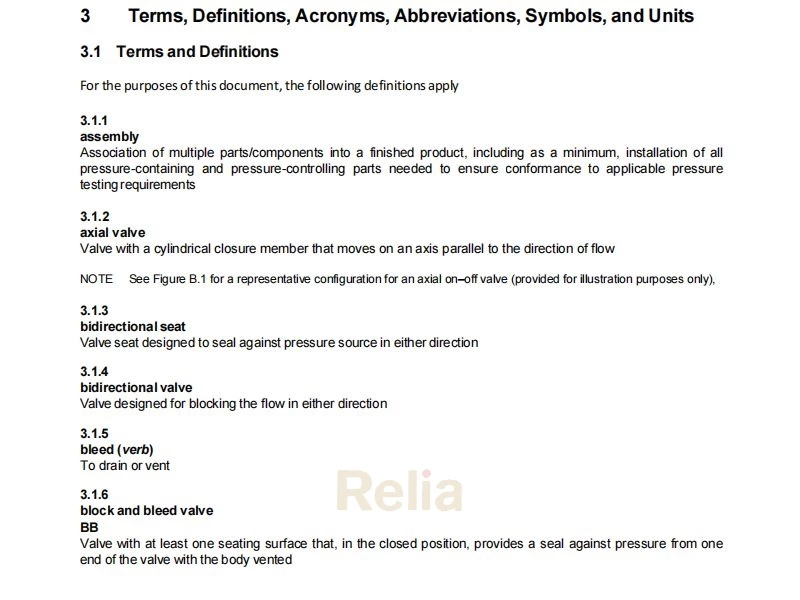API 6D Material Specifications
API 6D material specifications for metallic component, nonmetallic component, Composition Limits, impact test, Sour, Drain, Vent and Injection Components Service and Production Heat-t reating Equipment.
6 Materials
6.1 Metallic Requirements
6.1.1 General
Metallic pressure-containing or pressure-controlling materials in contact with process fluids shall have written material specifications which shall define the following:
― material grade,
― chemical analysis,
― heat treatment,
― mechanical properties (tensile), and,
― certification to report all items listed in 6.1.
Other requirements of the material specifications shall be as follows, when applicable:
― carbon equivalent (CE),
― Charpy impacts,
― hardness, and,
― other testing.
Metallic pressure-containing parts shall be made of materials consistent with the pressure–temperature rating as determined in conformance with 4.3.
NOTE 1 See K.10 for use options of other materials
NOTE 2 See API 20A, API 20B and API 20C for guidance on selection of casting and forging material manufacturers.
NOTE 3 See API 20J for guidance on use of outsourced distributors of metallic material.
6.1.2 Cast Parts
All cast material shall be manufactured using an industry-recognized process.
6.1.3 Forged Parts
All forged material shall be formed using a hot-working practice and heat treatment that produces a wrought (no cast dendritic elements) structure throughout the material.
All forged pressure-containing material shall have a minimum forge ratio of 3:1 as calculated per API 20B or API 20C. The forging ratio shall be included as part of the material certifications.
6.2 Nonmetallic Requirements
Nonmetallic seals in contact with process fluids shall have written material specifications which shall define the following:
― generic base polymer (see ASTM D1418,), if applicable,
NOTE 1 Reference to generic base polymer does not apply to graphite material,
― generic thermoplastic (see ASTM D4000), if applicable,
― physical property requirements;
― storage and age-control requirements.
NOTE 2 For guidance on qualification of polymeric seal manufacturers, see API 20L.
Elastomeric materials for valves in gas service at pressures of Class 600 and above shall be anti-explosive decompression (AED) resistant.
NOTE See L.7 and L.8 for additional requirements for seals qualification testing.
6.3 Composition Limits
The chemical composition of carbon steel pressure-containing and pressure-controlling parts shall conform to the applicable material standard.
The chemical composition of carbon steel welding ends shall meet the following requirements.
― The carbon content shall not exceed 0.23 % by mass.
― The sulfur content shall not exceed 0.020 % by mass.
― The phosphorus content shall not exceed 0.025 % by mass.
― The carbon equivalent (CE) shall not exceed 0.43 %.
The CE shall be calculated in conformance with equation 2:
CE = C % + Mn/6 % + (Cr % + Mo % + V %) /5 + (Ni % + Cu %) /15 (2)
The chemical composition of other carbon steel parts shall conform to the applicable material standard.
The carbon content of austenitic stainless-steel welding ends shall not exceed 0.03 % by mass, except for stabilized material in which case a carbon content of up to 0.08 % by mass is permissible.
NOTE See K.11 for use options of other chemical composition.
6.4 Impact Test
Carbon, alloy, and stainless steel (except austenitic grades) for pressure-containing parts in valves with a specified design temperature below –20 °F (–29 °C) shall be impact-tested. The test method shall be the V-notch technique shall conform to ASTM A370 or ISO 148-1.
When using ISO 148-1, a striker with a radius of 8 mm shall be used.
NOTE Design standards or local requirements can require impact testing for minimum design temperatures higher than –20 °F (–29 °C).
A minimum of one impact test, comprised of a set of three specimens, shall be performed on a representative test bar of each heat of the material in the final heat-treated condition.
Test specimens shall be cut from a separate or attached block taken from the same heat, reduced by forging where applicable, and heat-treated to the same heat treatment, including stress relieving, as the product materials.
It is not necessary to retest pressure-containing parts stress relieved at or below the previous stress relieving temperature or 50 °F (28 °C) below of the tempering temperature of the original material.
The impact test shall be performed at the lowest temperature as defined in the applicable material specifications.
Impact test results for bolting material shall meet the requirements of the applicable material specification.
Impact test results for full-size specimens shall meet the requirements of Table 4 or Table 5, as applicable.
Test specimen orientation shall conform to the applicable material specification. If the material specification does not define test specimen orientation, either transverse or longitudinal direction shall be acceptable.
Table 4—Minimum V-notch Impact Requirements for Material other than
Duplex and Super Duplex Stainless Steel Full-size Specimen)
| Specified Minimum Tensile Strength |
Average of Three Specimens |
Minimum of Single Specimen |
|||
| KSI | MPa | Ft -lbs. | Joules | Ft-lbs. | Joules |
| ≤85 | ≤586 | 15 | 20 | 12 | 16 |
| >85 to 100 | >586 to 689 | 20 | 27 | 16 | 21 |
| >100 | >689 | 25 | 34 | 19 | 26 |
Table 5―Minimum V-notch Impact Requirements for
Duplex and Super Duplex Stainless Steel
(Full-size Specimen)
| Minimum Test Temperature | Average of Three Specimens | Minimum of Single Specimen | |||
| °F | °C | Ft-lbs. | Joules | Ft-lbs. | Joules |
| –50 | –46 | 33 | 45 | 26 | 35 |
Where the material specification for the pipeline design standard requires impact values to be higher than those shown in Table 4, the higher values shall apply.
If an impact test fails, then a retest of three additional specimens removed from the same TC, with no additional heat treatment, may be made, each of which shall exhibit an impact value equal to or exceeding the required average value.
If sub size specimens are used, the Charpy V-notch impact requirements shall be equal to that of the 10 mm x 10 mm specimens multiplied by the adjustment factor listed in Table 6 at the full-size specimen test temperatures.
6.5 Sour Service
Metallic materials for use in sour service shall conform to NACE MR0175/ ISO 15156 (all parts).
NOTE For guidance to use of NACE MR0175/ ISO 15156 (all parts) on bolting see L.12.
Table 6― Adjustment Factors for Sub - size Impact Specimens
| Specimen (Dimension) | Adjustment Factor |
| 10mm x10mm (full size) | 1 (none) |
| 10 mm x 7.5 mm | 0.833 |
| 10 mm x 6.7 mm | 0.780 |
| 10 mm x 5.0 mm | 0.667 |
| 10 mm x 3.3 mm | 0.440 |
| 10 mm x 2.5 mm | 0.333 |
6.6 Drain, Vent and Injection Components
Materials for drain, vent and injection components shall be the same as the valve body material or made from a corrosion-resistant material.
6.7 Production Heat-t reating Equipment
6.7.1 General
Heat-treating using batch or continuous type furnaces for pressure-containing parts, pressure-controlling parts and TCs shall be performed with equipment that is used to process production parts meeting the requirements of this Specification. These requirements shall not apply to surface coatings or localized PWHT.
Heat treatment of production parts shall be performed with heat-treating equipment that satisfies one of the following:
— Calibrated in accordance with 6.7.2 and 6.7.3 and heat-treat batch-type furnaces that have been surveyed in accordance with Annex H; or,
— Calibrated and surveyed in accordance with SAE AMS 2750EE Class 1, 2 or 3 for tempering and Class 1, 2, 3, 4 or 5 for normalizing and austenitizing. See Table 7.
Table 7— Heat Treatment Therma l Uniformity Survey (TUS) Requirements
| Heat Treatment Type | Furnace Classes | ||||
| Class 1 TUS Tolerance ±5°F (±3°C) |
Class 2 TUS Tolerance ±10°F (±6°C) |
Class 3 TUS Tolerance ±15°F (±8°C) |
Class 4 TUS Tolerance ±20°F (±10°C) |
Class 5 TUS Tolerance ±25°F (±14°C) |
|
| Normalizing | X | X | X | X | X |
| Annealing | X | X | X | X | X |
| Solution Annealing | X | X | X | X | X |
| Austenitizing | X | X | X | X | X |
| Tempering | X | X | X | — | — |
| Precipitation Hardening | X | X | X | — | — |
| Aging | X | X | X | — | |
| Stress Relieving | X | X | X | — | |
| NOTE Symbol “—” used to show actions that are not applicable | |||||
Automatic controlling and recording instruments shall be used.
Thermocouples shall be placed in the furnace working zone(s) and protected from furnace atmospheres by means of suitable protective devices.
NOTE 1 For use of outsourced heat treatment services for Batch-type furnaces, see API 20H for guidance.
NOTE 2 For use of outsourced heat treatment services for Continuous-type furnaces, see API 20N for guidance.
6.7.2 Instrument Accuracy
The controlling and recording instruments used for the heat-treatment processes shall be accurate to ± 1 % of their full-scale range.
Automatic controlling and recording instruments shall be used.
6.7.3 Instrument Calibration
Temperature-controlling and recording instruments shall be calibrated at least once every 3 months.
6.7.4 Production Type Equipment– Batch Type Furnaces
6.7.4.1 Furnace Surve y Temperature Tolerance
The following criteria shall be satisfied when performing a temperature survey in accordance with Annex H.
6.7.4.1.1 Austenitizing, Normalizing, Annealing or Solution Annealing Furnaces
The temperature at any point in the working zone of a furnace used for austenitizing, normalizing, annealing or solution annealing shall not vary by more than ± 25 °F (± 14 °C) from the furnace set-point temperature after the furnace working zone has been brought up to temperature. Before the furnace set-point temperature is reached, none of the temperature readings shall exceed the set-point temperature by more than the temperature tolerance.
6.7.4.1.2 Tempering, Aging or Stress-relieving Furnaces
Furnaces which are used for tempering, aging and/or stress-relieving shall not vary by more than ±15 °F (± 8 °C) from the furnace set-point temperature after the furnace working zone has been brought up to temperature. Before the furnace set-point temperature is reached, none of the temperature readings shall exceed the set-point temperature by more than the temperature tolerance.
6.7.4.1.3 Multiple Use Furnaces
For furnaces used for heat treatment operations identified in 6.7.4.1.1 and 6.7.4.1.2, the heat treatment supplier shall define the temperature range for each operation. The furnace temperature uniformity survey shall conform to the requirements specified in 6.7.4.1.1 and 6.7.4.1.2, as appropriate for the process used.
6.7.4.2 Temperature Uniformity Survey Frequency
The temperatures within each batch-type furnace shall be surveyed within 1 year prior to use of the furnace for heat treatment in conformance with Annex H.
6.7.4.3 Furnace Repairs
When a furnace is repaired or rebuilt, a new temperature survey shall be carried out before the furnace is used for heat treatment, subject to the following. Repairs that return the furnace to the condition it was in at the time of the previous furnace survey and calibration or repairs that do not affect the temperature tolerance of the furnace shall not require a new temperature survey and calibration.
The SAE AMS 2750 sections on furnace modifications and furnace repairs shall be used to determine whether a new furnace survey is required. All furnace repairs and modifications shall be documented, and the responsible Quality Assurance organization shall make determination whether an additional furnace survey and calibration is required based on the repairs or modifications in conformance with SAE AMS2750 or SAE AMS-H-6875.
6.7.5 Production Type Equipment–Continuous-type Furnaces
Continuous-type furnaces shall be operated, maintained, modified, and repaired in conformance with SAE AMS2750 or SAE AMS-H-6875.
Continuous-type furnaces shall be surveyed in conformance with Annex H.
6.7.6 Records Retention
Records of furnace calibration and surveys shall be maintained for a period not less than 5 years. The minimum records of furnace calibration/survey shall be a certificate of conformance in accordance with Annex H.
